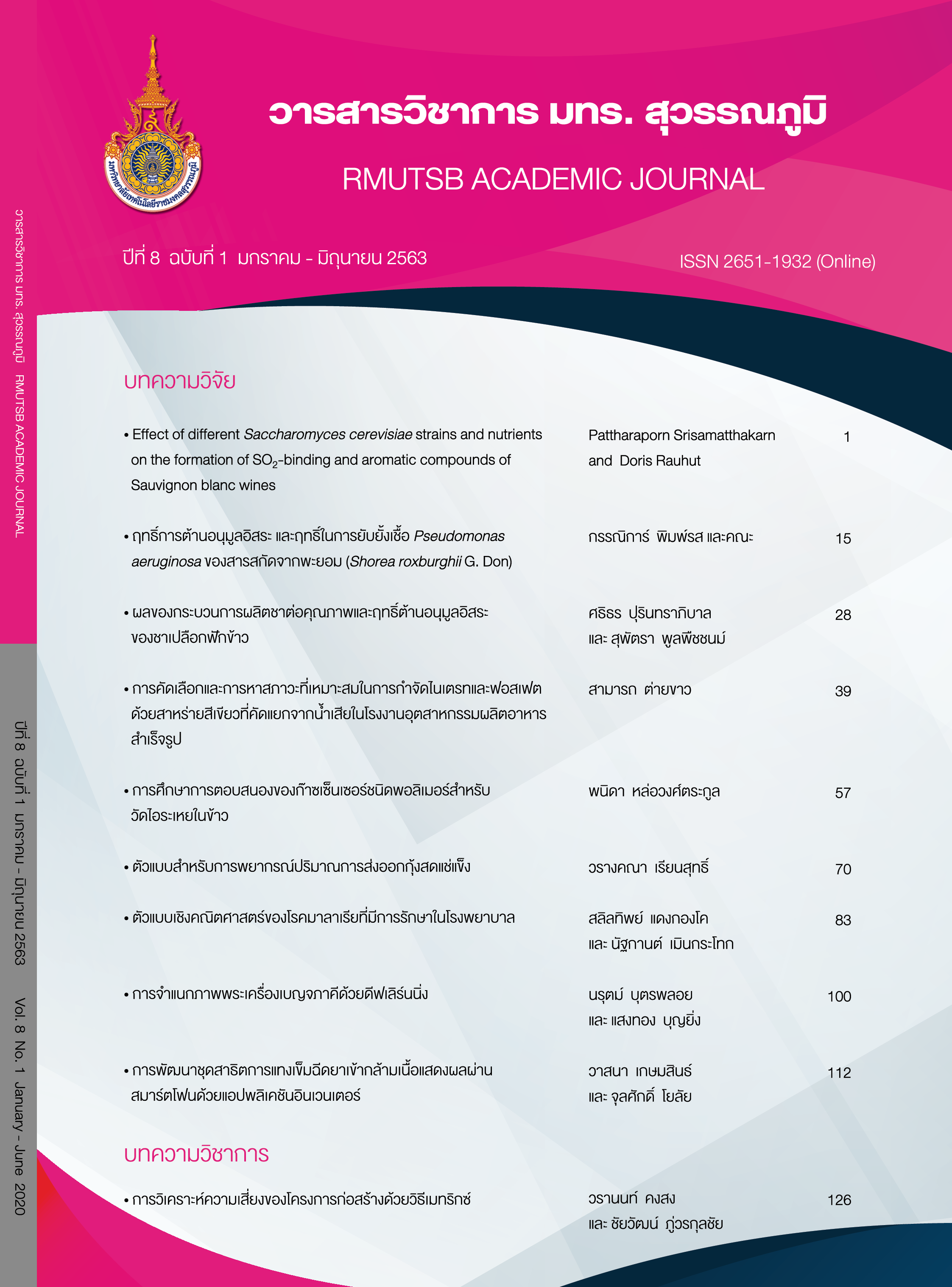การพัฒนาชุดสาธิตการแทงเข็มฉีดยาเข้ากล้ามเนื้อแสดงผลผ่านสมาร์ตโฟน ด้วยแอปพลิเคชันอินเวนเตอร์
Main Article Content
บทคัดย่อ
งานวิจัยนี้มีวัตถุประสงค์ 1) เพื่อพัฒนา 2) เพื่อทดสอบประสิทธิภาพการทำงาน และ 3) เพื่อศึกษาความพึงพอใจของผู้ใช้งานชุดสาธิตการแทงเข็มฉีดยาเข้ากล้ามเนื้อแสดงผลผ่านสมาร์ตโฟนด้วยแอปพลิเคชันอินเวนเตอร์ ซึ่งเป็นการพัฒนาชุดสาธิตที่มีอยู่เดิม โดยประยุกต์ใช้ผ้านำไฟฟ้าเป็นเซนเซอร์ตรวจจับการแทงเข็มฉีดยาแต่ละจุด ใช้ไมโครคอนโทลเลอร์ตระกูลเอวีอาร์ในการประมวลผลการทำงาน ประกอบเข้ากับหุ่นไฟเบอร์ครึ่งตัวชาย ตัดคอ มีแขนติดตั้งบนฐานที่สามารถปรับความสูง-ต่ำได้ ชุดสาธิตฯ สามารถแสดงผลของการแทงเข็มด้วยหลอดแอลอีดี และสามารถแสดงผลผ่านสมาร์ตโฟนในระบบปฏิบัติการแอนดรอยด์ได้ด้วยเทคโนโลยีบลูทูธ ผลการวิจัยพบว่า ความคล้ายทางกายวิภาคศาสตร์ อยู่ในระดับมากค่าเฉลี่ยเท่ากับ 4.36 (คะแนนเต็ม 5.00) และส่วน-เบี่ยงเบนมาตรฐานเท่ากับ 0.17 ประสิทธิภาพด้านความเที่ยงตรงของการแสดงผลด้วยแอลอีดี การเตือนด้วยเสียง และการแสดงผลผ่านสมาร์ตโฟนในระบบปฏิบัติการแอนดรอยด์ คิดเป็นร้อยละ 100 ความพึงพอใจของผู้นำไปใช้งาน มีความพึงพอใจระดับมากค่าเฉลี่ยเท่ากับ 4.36 และส่วนเบี่ยงเบนมาตรฐานเท่ากับ 0.55 ชุดสาธิตการแทงเข็มฉีดยาเข้ากล้ามเนื้อแสดงผลผ่านสมาร์ตโฟน ด้วยแอปพลิเคชันอินเวนเตอร์ที่พัฒนาขึ้นสามารถใช้งานได้จริงและสามารถนำไปใช้กับการเรียนการสอนในหลักสูตรสาธารณสุขศาสตร์ มหาวิทยาลัยราชภัฏสกลนคร ในรายวิชาที่เกี่ยวข้องได้
Article Details
ต้นฉบับที่ได้รับการตีพิมพ์ถือเป็นสิทธิของเจ้าของต้นฉบับและของวารสารวิชาการ มทร.สุวรรณภูมิ เนื้อหาบทความในวารสารเป็นแนวคิดของผู้แต่ง มิใช่เป็นความคิดเห็นของคณะกรรมการการจัดทำวารสาร และมิใช่ความรับผิดชอบของมหาวิทยาลัยเทคโนโลยีราชมงคลสุวรรณภูมิ
เอกสารอ้างอิง
Bloom, B. S. (1956). Taxonomy of educational objectives: The classification of educational goals. Handbook I: Cognitive domain (2nd ed.). New York: Longmans.
Kovindha, A. (2017). Innovation for medical rehabilitation. Rehabilitation Medicine, 27(1), A. (in Thai)
Boonnuddar, N. (2016). Mobile application: Patients' adherence for medicine in-take schedules (Master’s thesis). King Mongkut’s University of Technology North Bangkok, Bangkok. (in Thai)
Craven, R. F., Hirnle, C. J., Jensen, S. (2007). Fundamental of nursing: Human health and function (7th ed.). Philadelphia: Lippincott Williams & Wilkins.
Eknithiset, R. (2017). Muscular system. Retrieved 15 January 2020, from http://www.elfit.ssru.ac.th/rapat_ek/pluginfile.php/63/mod_page/content/89/Subject-Muscles.pdf (in Thai)
Joampak, O. (2018). Study characteristic photo sensor of tablet and capsule counting machine. In Proceeding of the Mechanical Engineering Network of Thailand Conference 32th (ME-NET 2018) (pp. 123-131). Mukdahan: Rajamangala University of Technology Isan.
Berman, A., Snyder, S., Kozier, B., & Erb, G. (2012). Kozier & Erb's Fundamentals of Nursing: Concepts, process, and practice (8th ed.). Upper Saddle River, NJ: Pearson Prentice Hall.
Malkin B. (2008). Are techniques used for intramuscular injection based on research evidence?. Nurs Times, 12(104), 48-51.
Nakhon Pathom Rajabhat University.(2017). Chapter 11 injectable drugs. Retrieved 6 March 2020, from http://courseware.npru.ac.th/admin/files/20170115134640_5c4f76fc95a0fd5f085706f931e74c5e.pdf (in Thai)
Potter, P. A., Perry, A. G., Stockert, P., & Hall, A. (2012). Fundamentals of nursing (8th ed.). St. Louis: Elsevier.
Wontaisong, N. (2017). The innovation of deltoid muscle model. SNRU Journal of Science and Technology, 9(2), 483-490. (in Thai)


